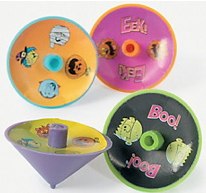We assume you are working through the PD area of the Resource in the suggested sequence. In a PD setting with a group of teachers, we would easily spend 2½ hours studying and discussing this page.
Doing science begins with observing the physical world, then trying to account for what happens. What causes the cycle of night and day? What causes the color of the ocean? What causes water to boil? And so forth. In other words, doing science involves developing explanations for observations based on cause and effect.
In a responsive teaching environment, students engage in practices of science to learn core disciplinary ideas. Students begin by observing the physical world, then try to account for what happens. What causes a toy car to roll down a ramp? What causes rain to fall? What causes a bulb to light? And so forth. In other words, like scientists, students develop explanations based on cause and effect.
Also like scientists, when faced with unknown phenomena, students share ideas based on a variety of experiences and knowledge to help them explain it. Identifying which student ideas might be productive to pursue is key to responsive teaching, and is an area that we revisited many times in our project. One of our early teacher meetings regarding this is highlighted below.

Dorothy, a sixth grade teacher, posed an interesting task as an icebreaker activity for her students at the beginning of a school year. She hoped to generate enthusiasm among the students for science, and to begin working with them responsively.
The Task: Student pairs were given small toy tops to spin on their desktops, similar to the tops shown here, and asked to describe how and why the tops moved as they did.
Dorothy brought three video clips of her students' discussions to our meeting. Below are two of the clips. Open or print the transcripts for easy reference.
Video Clip 1
Examine the video. Identify student ideas about the motion of the top. Are all of their ideas based on cause and effect? Are there any ideas that you do not understand? Are there any ideas that seem unlikely to be helpful in explaining the motion of the top?
Do not select ideas simply because you agree with them or they might lead to a right explanation. Cite line numbers from the transcripts for evidence.
Before watching the videos, teachers explored the top's motion for themselves for about 40 minutes. They noted several aspects of the motion, including that the top would spin in one direction, then when it toppled it would spin on the tabletop in the opposite direction.
Next Dorothy shared with teachers the same video of her students that you watched above. Teachers discussed the video for another 40 minutes, looking for examples of students' descriptions and explanations for the motion of the top. As they talked, teachers tried to genuinely understand students' ideas.
Video Clip 2
Examine the video. What student ideas did teachers identify? Which ideas do you think seem like the beginnings of scientific reasoning, in other words, based on cause and effect? Donna points out that it doesn't make sense to her that gravity causes the top's motion. What is her reason? Alice is concerned about pursuing a student idea that might not be "correct." What do you think about doing that within a responsive environment?
The teachers and project staff had a lengthy discussion of the students' ideas and their merits for pursuit. Snippets of that discussion are shown below. You will notice that one of the project staff, David, participated through video conferencing.
Video Clip 3
Examine the video. Why does David discount the old man analogy, and the suggestion of gravity? Why does he favor the backspin, toppling and bump ideas as worthy of pursuit?
Below is another video from Dorothy's class. Look for student ideas that might provide the beginnings of a scientific discussion addressing cause and effect, and ideas that most likely will not.
Video Clip 4
Examine the video. What student ideas might be worth pursuing for a scientific explanation—not necessarily ideas that might lead to a correct explanation? Are there ideas that will not likely lead to a scientific explanation? Cite line numbers from the transcripts for evidence.
In the video below, the teachers and David discuss the student snippet that you just viewed.
Video Clip 5
Examine the video. For David, what differentiates the girl-on-the-swing idea from the backspin, toppling or bump ideas? How does he suggest addressing the girl-on-the-swing idea?
What conclusions can you draw from this page? What criteria could guide you in choosing which student ideas to pursue? How could you address ideas that do not seem useful to pursue? What might change your mind regarding the worthiness of an idea?
In the first half of the teacher meeting showcased here, teachers were struggling with how to be responsive. After viewing the first student video, one suggestion was to begin a discussion of variables stemming from Jarus's backspin idea. For example, the class could compare the axes of spin for the ball and for the top, then connect that to axes in math, and so forth. The suggestion seemed like a convenient way to move toward district standards. How is launching a discussion of variables from Jarus's idea fundamentally different from what is discussed on this web page?